Why this resume works
- Quantifies accomplishments: The applicant’s resume accomplishments, like boosting client satisfaction by 25%, illustrate their significant impact in therapy roles.
- Showcases career progression: Transitioning from athletic trainer to sports therapist, the applicant shows career progression with increased responsibilities, such as leading therapy sessions and developing recovery plans.
- Uses action-oriented language: Action verbs like “developed” and “implemented”, convey initiative and effectiveness.
More Sports Therapist Resume Examples
Take a look at our sports therapist resume examples to learn how to highlight your therapy skills, client interactions, and recovery plans. These physical therapy resume samples will help you create a resume that appeals to various healthcare settings.
Entry-Level Sports Therapist
Why this resume works
- Centers on academic background: The applicant’s education section, featuring a master’s in sports therapy, showcases strong foundational knowledge essential for early career success.
- Effective use of keywords: Strategically placed keywords like “athlete rehabilitation” and “performance enhancement” ensure the resume aligns with applicant tracking systems (ATS) criteria effectively.
- Shows digital literacy: Using digital platforms to manage client portfolios demonstrates the applicant’s strong computer skills and readiness for modern workplace demands.
Mid-Level Sports Therapist
Why this resume works
- Points to measurable outcomes: Showcasing improved client mobility by 30% and reduced recovery time by 25%, the applicant effectively quantifies impact in sports therapy roles.
- Includes a mix of soft and hard skills: Combining technical skills with interpersonal skills, the applicant presents a well-rounded ability to design effective rehabilitation plans and conduct engaging therapy sessions.
- Demonstrates language abilities: With language skills in Spanish, French, and German, the applicant improves cross-cultural communication, supporting diverse client interactions in international settings.
Experienced Sports Therapist
Why this resume works
- Lists relevant certifications: Listing certifications like Certified Sports Therapist and Advanced Rehabilitation Techniques reflects a dedication to expertise in sports therapy.
- Showcases impressive accomplishments: Achieving a 30% improvement in athlete recovery showcases impressive accomplishments that demonstrate the applicant’s impact-driven approach.
- Emphasizes leadership skills: Managing a caseload of over 50 patients weekly highlights significant leadership skills in coordinating patient care and ensuring effective treatment plans.
Sports Therapist Resume Template (Text Version)
Olivia Martinez
Milwaukee, WI 53209
(555)555-5555
Olivia.Martinez@example.com
Professional Summary
Dynamic sports therapist with 9 years of experience in sports rehabilitation and athlete conditioning. Expert in injury assessment, advanced therapy, and program design, enhancing athlete recovery and performance.
Work History
Sports Therapist
Peak Performance Clinic – Milwaukee, WI
January 2022 – August 2025
- Developed recovery plans increasing recovery rate by 30%
- Led therapy sessions boosting client satisfaction by 25%
- Assessed injuries reducing downtime by 15%
Rehabilitation Specialist
Phoenix Rehabilitative Services – Brookfield, WI
June 2017 – December 2021
- Designed injury protocols decreasing injuries by 20%
- Conducted assessments improving patience outcomes by 35%
- Supervised staff reducing operational costs by 10%
Athletic Trainer
Velocity Sports Institute – Brookfield, WI
February 2014 – May 2017
- Implemented fitness programs enhancing agility by 40%
- Managed equipment enhancing safety compliance by 15%
- Collaborated with coaches improving team performance by 25%
Skills
- Injury Assessment
- Rehabilitation Planning
- Therapeutic Exercises
- Athlete Consultation
- Sports Conditioning
- Manual Therapy
- Fitness Program Design
- Patient Outcome Evaluation
Education
Master’s in Sports Therapy Sports Therapy
University of Southern California Los Angeles, California
June 2013
Bachelor’s in Kinesiology Kinesiology
University of Colorado Boulder Boulder, Colorado
June 2011
Certifications
- Certified Athletic Therapist – National Athletic Trainers Association
- Advanced Kinesiology Certificate – American Kinesiology Association
Languages
- Spanish – Beginner (A1)
- French – Intermediate (B1)
- German – Beginner (A1)
Related Resume Guides
Advice for Writing Your Sports Therapist Resume
Get ready to discover tips on how to write a resume that highlights your sports therapy skills, education, and passion. Whether you’re just starting out or have years of experience, these tailored insights will help you craft a winning resume that catches the eye of potential employers.
Write a strong professional summary
A professional summary on a resume acts as an introduction for hiring managers, offering them a quick snapshot of your career.
This type of summary provides a brief overview of your skills, achievements, and past experience. It’s particularly useful for experienced applicants who want to showcase their professional identity and value immediately. By including this section, you can highlight what you’ve accomplished in your career up to this point.
Resume objectives, by contrast, focus on career aspirations and future contributions. They are ideal for entry-level job seekers, individuals making career changes, or those with employment gaps. Unlike summaries that emphasize past accomplishments, objectives outline what you aim to bring to the role you’re pursuing.
Below, we’ll explore examples of both summaries and objectives tailored to various industries and levels of experience. These examples will guide you in crafting the perfect introduction for roles such as sports therapist or other positions you’re targeting!
Sports therapist resume summary examples
Entry-level
Recent graduate in sports therapy with a Bachelor of Science degree, well-versed in injury prevention and basic rehabilitation techniques. Certified in CPR and First Aid, with foundational skills in therapeutic exercises and patient assessment. Eager to apply academic knowledge and clinical experience to support athletes’ recovery and performance enhancement.
Mid-career
Sports therapist with over six years of experience working with collegiate athletes and sports teams. Proven track record in developing individualized treatment plans, conducting bio mechanical assessments, and facilitating post-injury rehabilitation. Holds a certification in dry needling and is known for fostering strong athlete relationships through effective communication and trust-building.
Experienced
Veteran sports therapist specializing in high-performance athlete care and rehabilitation strategies. Over 15 years of experience collaborating with professional sports teams to improve athletic performance while minimizing injury risks. Expert in advanced manual therapy techniques, return-to-play protocols, and leading multidisciplinary teams to achieve comprehensive care solutions.
Sports therapist resume objective examples
Recent graduate
Driven recent graduate with a Bachelor of Science in sports therapy from an accredited program, eager to begin a career as a sports therapist. Looking to apply foundational knowledge and hands-on training in injury prevention and rehabilitation to support athletes in optimizing performance and recovery.
Career changer
Passionate professional transitioning from fitness coaching to sports therapy, equipped with skills in athletic training and client motivation. Aims to leverage experience in personalized fitness plans and injury management to foster athlete wellness and resilience within a collaborative team setting.
Entry-level applicant
Aspiring sports therapist with internship experience in athletic environments seeking an entry-level position. Committed to applying practical understanding of biomechanics and therapeutic techniques to assist athletes in achieving peak physical condition while minimizing risk of injury.
Boost your chances of landing a sports therapist job by using our Resume Builder to create a polished and professional resume quickly.
Include relevant certifications and training
For a sports therapist, listing certifications and training is important because it shows your skills and knowledge to employers. Certifications prove that you know the latest techniques and standards in the field. They also show that you are committed to keeping your skills up-to-date. Having these credentials can help you stand out in a technical field where expertise is key.
- Certified Athletic Trainer (ATC)
- Licensed Massage Therapist (LMT)
- Certified Strength and Conditioning Specialist (CSCS)
- Physical Therapy License
- First Aid and CPR Certification
A dedicated certifications section on your resume makes it easy for employers to see your qualifications. It complements your education section by highlighting specialized skills. This can make a big difference in landing a job as a sports therapist.
Example of a certifications section
Certified Sports Therapist
Issued by: National Athletic Trainers’ Association (NATA)
Issued 2021
Certified Strength and Conditioning Specialist (CSCS)
Issued by: National Strength and Conditioning Association (NSCA)
Expires 2025
Manual Therapy Certification
Issued by: American Academy of Orthopaedic Manual Physical Therapists (AAOMPT)
Issued 2020
Dry Needling Certification
Issued by: American Academy of Manipulative Therapy (AAMT)
Issued 2019
Kinesio Taping Practitioner Certification
Issued by: Kinesio Taping Association International (KTAI)
Expires 2026
Choose a resume template with a simple and professional layout that avoid flashy designs and improves your chances of passing ATS.
Showcase your work experience
Relevant work experience is key to demonstrating your ability to excel in this role. When formatting your experience, start with the most recent job and list each position in reverse chronological order. Include the job title, employer name, location, and employment dates for each position.
This format allows hiring managers to easily see your career progression and understand how your background aligns with their needs.
Use action-oriented language to highlight responsibilities and achievements in each role. Focus on measurable outcomes that demonstrate your impact, such as “developed tailored rehabilitation plans for 15+ athletes recovering from injuries, resulting in an average recovery time reduction of 20%.”
Include core responsibilities like assessing clients’ physical conditions, creating therapy programs, conducting injury prevention training, and providing hands-on treatment. By showcasing specific results or improvements you’ve contributed to, you show not just what you did but why it mattered.
Tailor each description to emphasize skills important for a sports therapist role. Highlight tasks like monitoring progress during recovery programs, educating clients on proper techniques to avoid re-injury, or collaborating with other healthcare professionals. By focusing on accomplishments and clear examples of success, you create a compelling case for why you’re a great fit for the position.
5 sports therapist work history bullet points
- Conducted over 300 musculoskeletal assessments annually, improving recovery time by 25% for injured athletes.
- Implemented individualized therapy plans, leading to a 40% increase in client satisfaction scores within one year.
- Collaborated with coaching staff to design injury prevention programs, reducing overall team injuries by 15%.
- Trained 10+ interns and junior therapists on advanced rehabilitation techniques, improving team expertise.
- Used manual therapy and exercise interventions to restore functional mobility in post-surgery clients, achieving a 90% success rate.
For a sports therapist, select a resume format that highlights your hands-on therapy skills, relevant certifications, and experience with various athletic populations.
Match your resume with the job description
Tailoring resumes to job descriptions is essential because it helps job seekers stand out to employers and pass through ATS. These systems scan resumes for specific keywords and phrases from job postings, ensuring that only relevant applications reach hiring managers.
An ATS-friendly resume includes keywords and phrases that align with a person’s skills. This approach increases the chances of getting noticed by hiring managers, as it demonstrates the applicant’s qualifications closely match what the employer is looking for.
To identify keywords from job postings, look for skills, qualifications, and duties mentioned repeatedly. For instance, in a sports therapist role, terms like “patient care,” “clinical assessments,” or “healthcare team collaboration” might be common. Using exact phrases from the posting is key to ensure your resume matches what employers seek.
Incorporating these terms naturally into your resume content involves rewriting job descriptions effectively. For example, you can transform “provide high-quality patient care” into “delivered high-quality patient care to improve overall health outcomes.” This method shows your experience while including relevant keywords.
Targeted resumes improve ATS compatibility by aligning your skills with those sought by employers. When you customize your resume, this strategic approach improves your chances of securing interviews and advancing in the hiring process.
Try our ATS Resume Checker to quickly spot over 30 common resume issues like formatting and phrasing. Get instant tips to boost your resume’s chances of getting noticed by employers.
FAQ
Do I need to include a cover letter with my sports therapist resume?
Yes, including a tailored cover letter with your sports therapist resume can make a strong impression and increase your chances of landing an interview.
A cover letter gives you the opportunity to highlight your passion for helping clients recover and perform at their best while emphasizing specific skills like injury prevention or rehabilitation techniques.
If the clinic or team you’re applying to specializes in areas such as post-surgical recovery or athletic performance, you can discuss in the cover letter how your expertise aligns with their needs.
Consider using a Cover Letter Generator to quickly craft a professional and customized letter that complements your resume and showcases your unique qualifications.
You can also explore online cover letter examples to get inspiration for structuring and refining your message effectively within the sports therapy field.
How long should a sports therapist’s resume be?
For a sports therapist, a one-page resume is typically effective for succinctly presenting key skills like injury assessment, rehabilitation techniques, and patient communication. It keeps the focus on your qualifications and experiences that directly relate to the role.
However, if you have extensive experience or hold multiple certifications relevant to sports therapy, opting for a two-page resume might be appropriate. This allows more space to detail your specialized skills and significant achievements in the field.
Explore our guide on how long a resume should be to assess whether a one-page or two-page resume best suits your career stage and experience level.
How do you write a sports therapist resume with no experience?
Writing a resume with no experience as a sports therapist can feel challenging, but focusing on your education, skills, and related activities will help you stand out. Start by emphasizing your academic background and any certifications relevant to sports therapy. Follow these tips:
- Highlight education and certifications: Clearly list your degree in sports therapy or a related field. Include any certifications like CPR or First Aid that are relevant to the role.
- Leverage internships and volunteer work: If you’ve participated in internships or volunteered at clinics or sports organizations, detail these experiences. Describe your responsibilities and what you learned from them.
- Showcase transferable skills: Highlight skills such as communication, teamwork, and problem-solving abilities that are important for a sports therapist. Mention how you’ve developed these through group projects or team-based activities.
Rate this article
Sports Therapist
Additional Resources
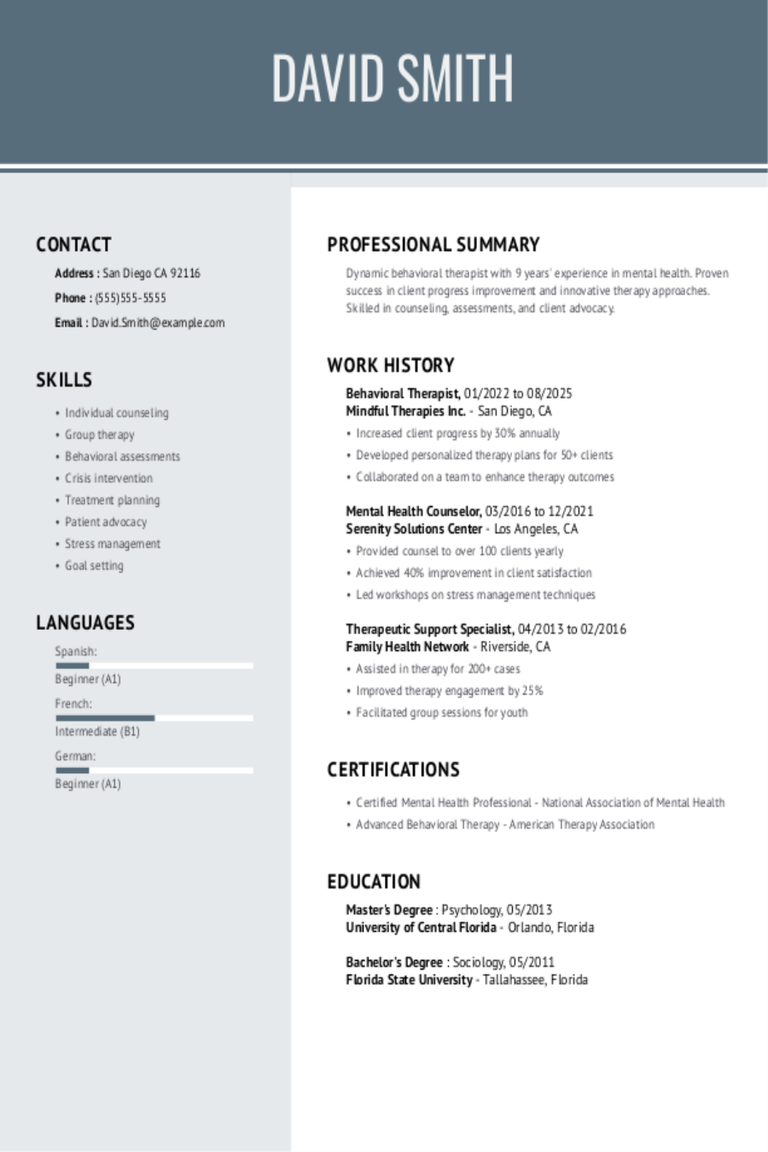
Behavioral Therapist Resume Examples & Templates for 2025
Browse behavioral therapist resume examples and learn how to highlight communication skills, empathy, and experience with different age groups while demonstrating your ability to create positive change in people’s lives.Build
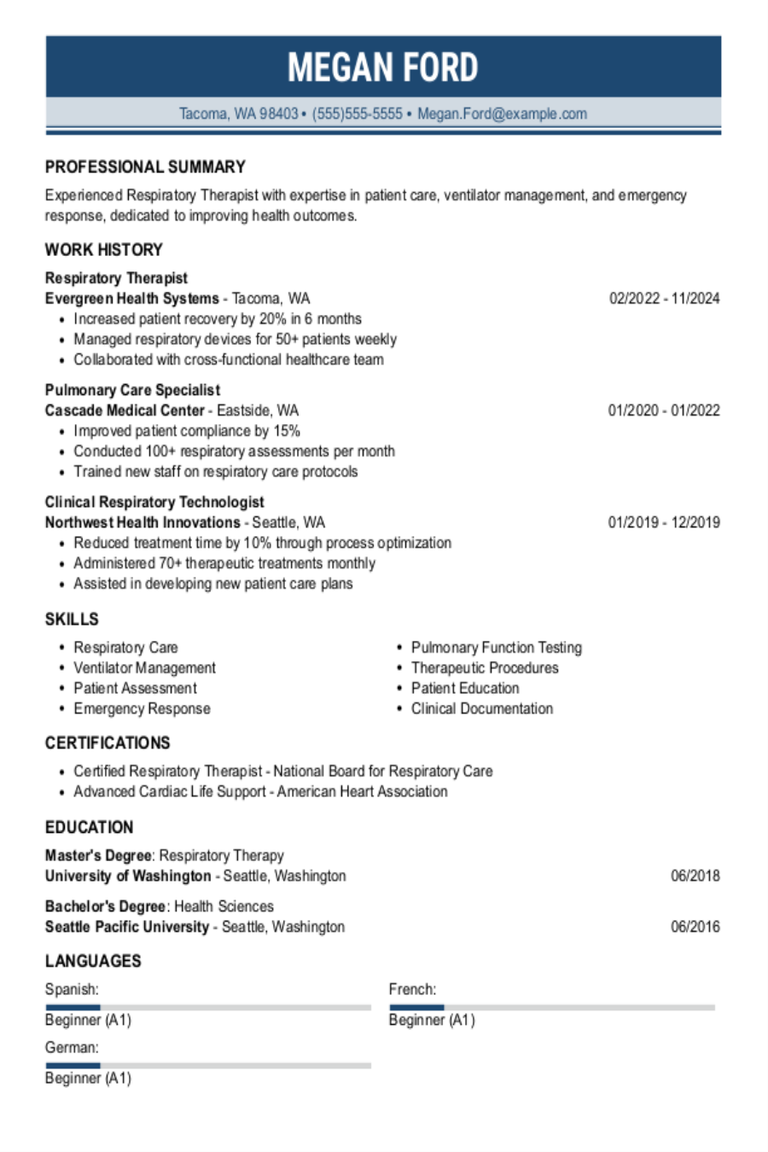
Respiratory Therapist Resume Examples & Templates for 2025
Browse respiratory therapist resume examples to see how to showcase your experience caring for patients with breathing problems and working with medical teams. These samples help you highlight your skills
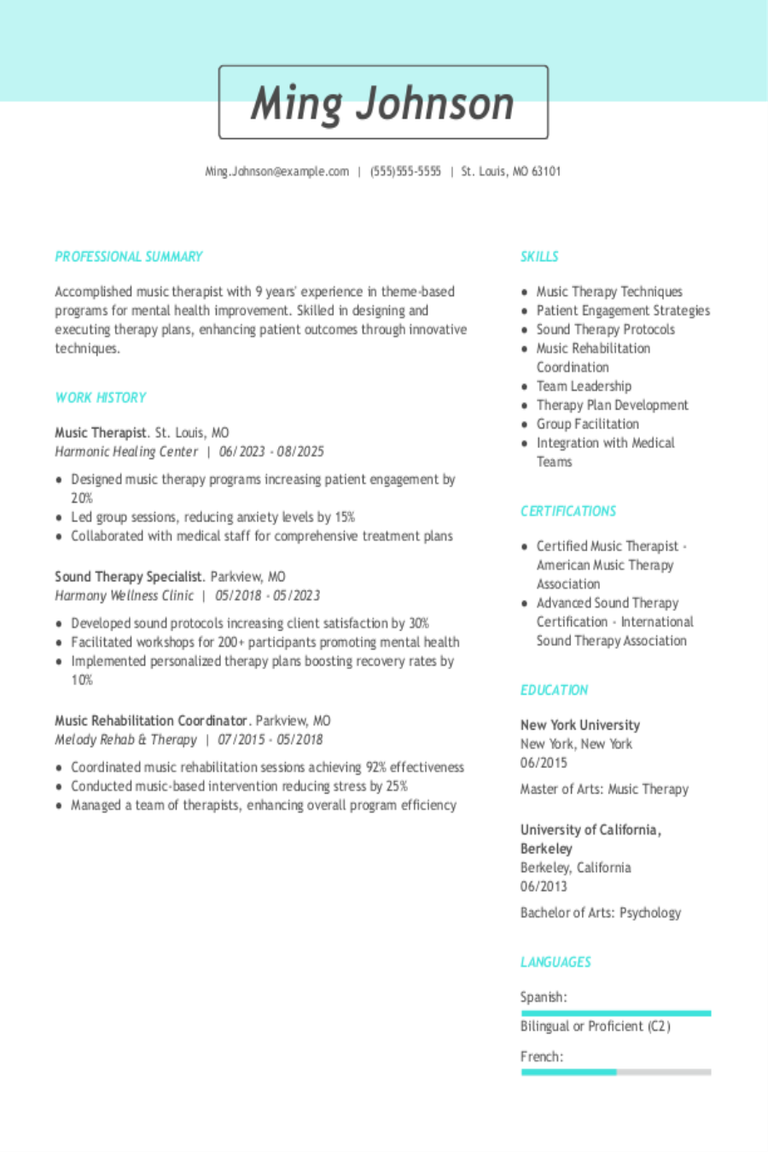
Music Therapist Resume Examples & Templates for 2025
Explore music therapist resume examples and tips to learn how to highlight your experience supporting clients, using music as a tool for healing, and building strong connections through creative therapy.Build
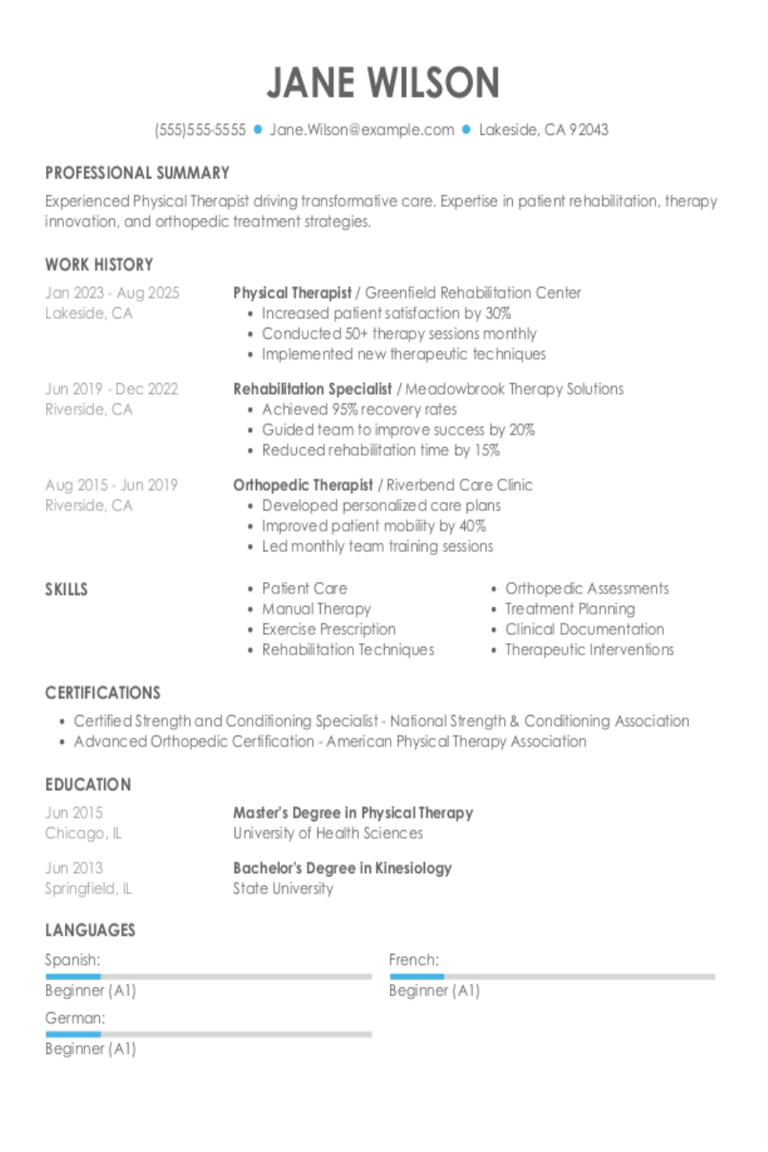
Physical Therapist Resume Examples & Templates for 2025
Discover physical therapist resume examples and learn how to showcase your ability to improve patient mobility and recovery.Build my resumeImport existing resumeCustomize this templateWhy this resume worksHighlights industry-specific skills: By incorporating
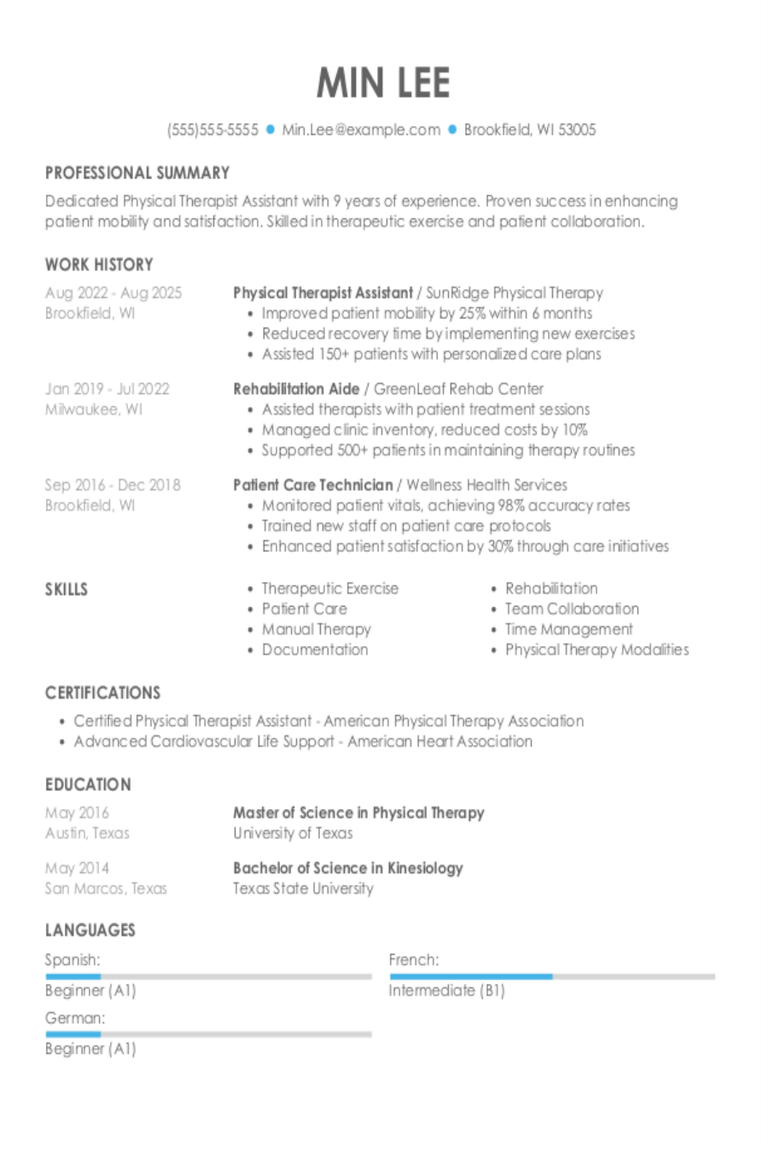
Physical Therapist Assistant Resume Examples & Templates for 2025
Explore physical therapist assistant resume examples and tips to help you showcase your teamwork skills and hands-on experience without sounding too technical.Build my resumeImport existing resumeCustomize this templateWhy this resume
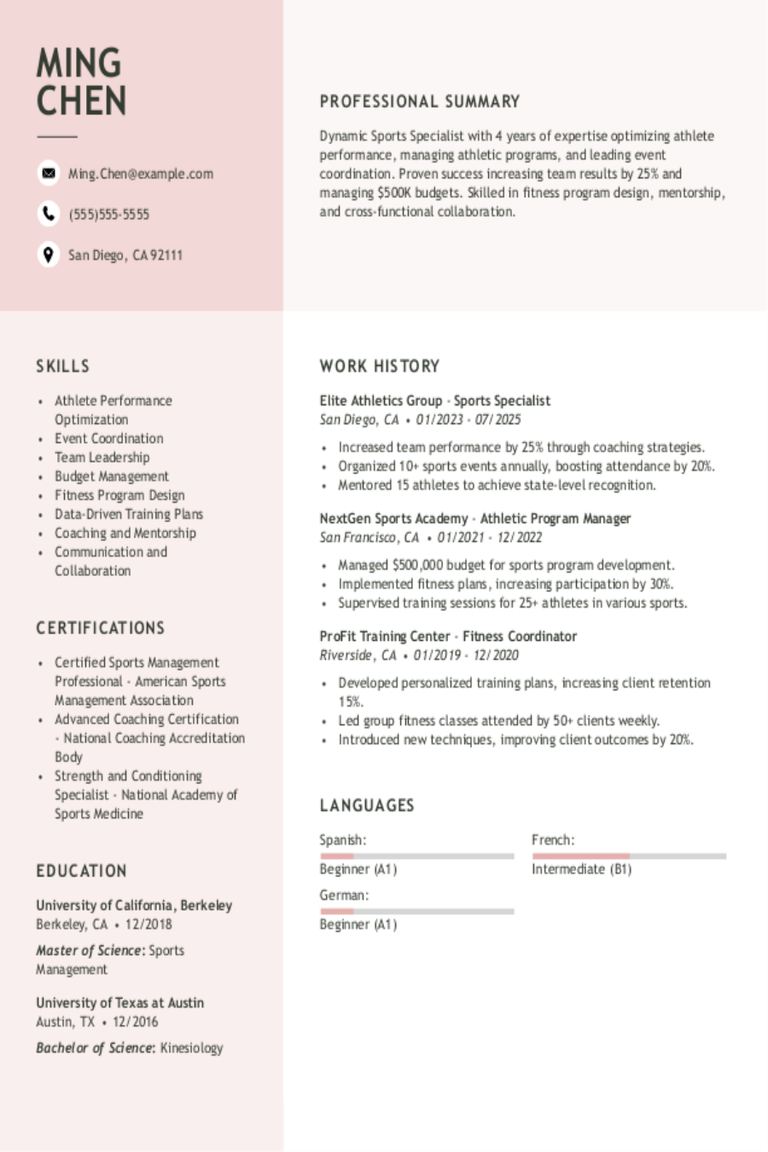
Sports Resume Examples & Templates for 2025
Sports resume examples can show you how to highlight teamwork, leadership, and discipline. Discover ways to showcase your achievements and experiences that make you stand out in the sports world.Build
